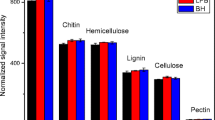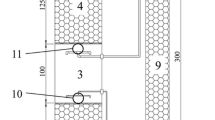Abstract
Temporal variation of general and rare bacterial taxa was investigated using pyrosequencing of 16S rRNA gene from activated sludge samples collected bimonthly for a two-year period. Most of operational taxonomic units (OTUs) were allocated to rare taxa (89.6%), but the rare taxa comprised a small portion of the community in terms of abundance of sequences analyzed (28.6%). Temporal variations in OTUs richness significantly differed between the two taxa groups in which the rare taxa showed a higher diversity and a more fluctuating pattern than the general taxa. Furthermore, the two taxa groups were constrained by different explanatory variables: influent BOD, effluent BOD, and DO were the significant (P < 0.05) parameters affecting the pattern of the general taxa, while temperature was the factor for the rare taxa. Over the test period, the general taxa persisted for a longer time (i.e., lower turnover rate) in the bioreactor than the rare taxa. In conclusion, this study demonstrated clear differences in temporal dynamic patterns for the general and rare bacterial taxa in an activated sludge bioreactor, which would be a foundation for better understanding the bacterial ecology of activated sludge.







Similar content being viewed by others
References
Adler PB, Lauenroth WK (2003) The power of time: spatiotemporal scaling of species diversity. Ecol Lett 6(8):749–756
APHA, AWWA, WPCF (1989) Standard methods for the examination of water and wastewater, 17th edn. APHA, AWWA, WPCF, Washington, DC
Ayarza JM, Erijman L (2010) Balance of neutral and deterministic components in the dynamics of activated sludge floc assembly. Microb Ecol 61(3):486–495
Briones A, Raskin L (2003) Diversity and dynamics of microbial communities in engineered environments and their implications for process stability. Curr Opin Biotechnol 14(3):270–276
Campbell BJ, Yu L, Heidelberg JF, Kirchman DL (2011) Activity of abundant and rare bacteria in a coastal ocean. Proc Natl Acad Sci U S A 108(31):12776–12781
Claesson MJ, O'Sullivan O, Wang Q, Nikkilä J, Marchesi JR, Smidt H, de Vos WM, Ross RP, O'Toole PW (2009) Comparative analysis of pyrosequencing and a phylogenetic microarray for exploring microbial community structures in the human distal intestine. Plos One 4(8):e6669
Dytczaka MA, Londryb KL, Oleszkiewicza JA (2008) Activated sludge operational regime has significant impact on the type of nitrifying community and its nitrification rates. Water Res 42(8–9):2320–2328
Frank JA, Reich CI, Sharma S, Weisbaum JS, Wilson BA, Olsen GJ (2008) Critical evaluation of two primers commonly used for amplification of bacterial 16S rRNA genes. Appl Environ Microbiol 74(8):2461–2470
Galand P, Casamayor E, Kirchman D, Lovejoy C (2009) Ecology of the rare microbial biosphere of the Arctic Ocean. Proc Natl Acad Sci USA 106(52):22427–22432
Hubble SP (2001) The unified neutral theory of biodiversity and biogeography. Princeton University Press, Princeton, NJ, USA
Jenkins D, Richard MG, Daigger GT (2003) Manual on the causes and control of activated sludge bulking and foaming, 3rd edn. IWA Publishing, London, UK
Jeong J-Y, Park H-D, Lee K-H, Weon H-Y, Ka J-O (2011) Microbial community analysis and identification of alternative host-specific fecal indicators in fecal and river water samples using pyrosequencing. J Microbiol 49(4):585–594
Kaewpipat K, Grady CPL (2002) Microbial population dynamics in laboratory-scale activated sludge reactors. Water Sci Technol 46(1–2):19–27
Kong Y, Xia Y, Nielsen JL, Nielsen PH (2007) Structure and function of the microbial community in a full-scale enhanced biological phosphorus removal plant. Microbiology 153:4061–4073
Kwon S, Kim TS, Yu GH, Jung JH, Park HD (2010) Bacterial community composition and diversity of a full-scale integrated fixed-film activated sludge system as investigated by pyrosequencing. J Microbiol Biotechnol 20(12):1717–1723
McCune B, Grace JB (2002) Analysis of ecological communities. MJM Software Design, Gleneden Beach, OR, USA
Metcalf E (2003) Wastewater engineering: treatment and reuse, 4th edn. McGraw-Hill, New York, NY
Moura A, Tacao M, Henriques I, Dias J, Ferreira P, Correia A (2009) Characterization of bacterial diversity in two aerated lagoons of a wastewater treatment plant using PCR-DGGE analysis. Microbiol Res 164(5):560–569
Muyzer G, Dewaal EC, Uitterlinden AG (1993) Profiling of complex microbial populations by denaturing gradient gel electrophoresis analysis of polymerase chain reaction-amplified genes coding for 16S rRNA. Appl Environ Microbiol 59(3):695–700
Obata K, Segawa O, Yakabe M, Ishida Y, Kuroita T, Ikeda K, Kawakami B, Kawamura Y, Yohda M, Matsunaga T, Tajima H (2001) Development of a novel method for operating magnetic particles, magtration technology, and its use for automating nucleic acid purification. J Biosci Bioeng 91(5):500–503
Ofiteru ID, Lunn M, Curtis TP, Wells GF, Criddle CS, Francis CA, Sloan WT (2010) Combined niche and neutral effects in a microbial wastewater treatment community. Proc Natl Acad Sci USA 107(35):15345–15350
Park HD, Noguera DR (2004) Evaluating the effect of dissolved oxygen on ammonia-oxidizing bacterial communities in activated sludge. Water Res 38(14–15):3275–3286
Pedros-Alio C (2006) Marine microbial diversity: can it be determined? Trends Microbiol 14(6):257–263
Preston FW (1960) Time and space and the variation of species. Ecology 41(4):611–627
Rittmann BE, McCarty PE (2001) Environmental biotechnology: principles and applications. McGraw-Hill Higher Education, New York, USA
Robinson GR, Quinn JF (1988) extinction, turnover and species diversity in an experimentally fragmented Californina annual grassland. Oecologia 76(1):71–82
Roesch LF, Fulthorpe RR, Riva A, Casella G, Hadwin AKM, Kent AD, Daroub SH, Camargo FAO, Farmerie WG, Triplett EW (2007) Pyrosequencing enumerates and contrasts soil microbial diversity. ISME J 1:283–290
Roh SW, Kim K-H, Nam Y-D, Chang H-W, Park E-J, Bae J-W (2009) Investigation of archaeal and bacterial diversity in fermented seafood using barcoded pyrosequencing. ISME J 4:1–16
Saikaly PE, Oerther DB (2011) Diversity of dominant bacterial taxa in activated sludge promotes functional resistance following toxic shock loading. Microb Ecol 61(3):557–567
Sanapareddy N, Hamp TJ, Gonzalez LC, Hilger HA, Fodor AA, Clinton SM (2009) Molecular Diversity of a North Carolina Wastewater Treatment Plant as Revealed by Pyrosequencing. Appl Environ Microbiol 75(6):1688–1696
Schloss PD, Westcott SL, Ryabin T, Hall JR, Hartmann M, Hollister EB, Lesniewski RA, Oakley BB, Parks DH, Robinson CJ, Sahl JW, Stres B, Thallinger GG, Van Hom DJ, Wber CF (2009) Introducing mothur: open-source, platform-independent, community-supported software for describing and comparing microbial communities. Appl Environ Microbiol 75:7537–7541
Schoener TW, Spiller DA (1987) High population persistence in a system with high turnover. Nature 330(6147):474–477
Sloan WT, Lunn M, Woodcock W, Head IM, Nee S, Curtis TP (2006) Quantifying the roles of immigration and chance in shaping prokaryote community structure. Environ Microbiol 8(4):732–740
van der Gast CJ, Whiteley AS, Thompson IP (2004) Temporal dynamics and degradation activity of an bacterial inoculum for treating waste metal-working fluid. Environ Microbiol 6(3):254–263
van der Gast CJ, Ager D, Lilley AK (2008) Temporal scaling of bacterial taxa is influenced by both stochastic and deterministic ecological factors. Environ Microbiol 10(6):1411–1418
Wagner M, Loy A (2002) Bacterial community composition and function in sewage treatment systems. Curr Opin Biotechnol 13(3):218–227
Wagner M, Amann R, Lemmer H, Schleifer KH (1993) Probing activated sludge with oligonucleotides specific for proteobacteria: inadequacy of culture-dependent methods for describing microbial community structure. Appl Environ Microbiol 59(5):1520–1525
Wang Q, Garrity GM, Tiedje JM, Cole JR (2007) Naive bayesian classifier for rapid assignment of rRNA sequences into the new bacterial taxonomy. Appl Environ Microbiol 73(16):5261–5267
Wells GF, Park HD, Yeung CH, Eggleston B, Francis CA, Criddle CS (2009) Ammonia-oxidizing communities in a highly aerated full-scale activated sludge bioreactor: betaproteobacterial dynamics and low relative abundance of Crenarchaea. Environ Microbiol 11(9):2310–2328
Wells GF, Park HD, Eggleston B, Francis CA, Criddle CS (2011) Fine-scale bacterial community dynamics and the taxa-time relationship within a full-scale activated sludge bioreactor. Water Res 45(17):5476–5488
White EP, Adler PB, Lauenroth WK, Gill RA, Greenberg D, Kaufman DM, Rassweiler A, Rusak JA, Smith MD, Steinbeck JR, Waide RB, Yao J (2006) A comparison of the species-time relationship across ecosystems and taxonomic groups. OIKOS 112(1):185–195
Xia SQ, Duan LA, Song YH, Li JX, Piceno YM, Andersen GL, Alvarez-Cohen L, Moreno-Andrade I, Huang CL, Hermanowicz SW (2010) Bacterial community structure in geographically distributed biological wastewater treatment reactors. Environ Sci Technol 44(19):7391–7396
Acknowledgement
We would like to thank Professor S. Hwang for providing DNA samples of the Pohang WWTP and the engineers of the Pohang WWTP for providing samples and operational data. This study was funded by grants from the National Research Foundation of Korea to H.-D. Park (K20901001306-09B1200-10310).
Author information
Authors and Affiliations
Corresponding author
Additional information
Submission as an original article to Applied Microbiology and Biotechnology
Rights and permissions
About this article
Cite this article
Kim, TS., Jeong, JY., Wells, G.F. et al. General and rare bacterial taxa demonstrating different temporal dynamic patterns in an activated sludge bioreactor. Appl Microbiol Biotechnol 97, 1755–1765 (2013). https://doi.org/10.1007/s00253-012-4002-7
Received:
Revised:
Accepted:
Published:
Issue Date:
DOI: https://doi.org/10.1007/s00253-012-4002-7




